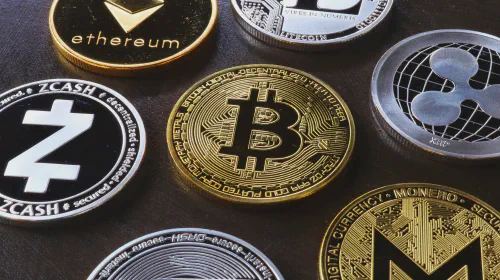Chainlink: Decentralized Oracle Network Explained
Salomon Kisters
Dec 21, 2022This post may contain affiliate links. If you use these links to buy something we may earn a commission. Thanks!
Blockchain technology, introduced barely over a decade ago, has now grown into a diverse space with alternative decentralized options for our traditional centralized financial system and governing model.
However, one of the biggest challenges faced by blockchain projects today is incompatibility with centralized platforms and applications, which act as a barrier that keeps blockchain technology from accessing data and knowledge from the real world.
Chainlink provides an incredibly innovative solution to this problem by using a decentralized oracle network system that connects non-blockchain sources with blockchain platforms for the seamless transfer of data and information.
However, there is a lot more to this new blockchain project than meets the eye.
In today’s article, we will dive deep into Chainlink and discuss how the project works.
Why Was Chainlink Made?
The first blockchain, Bitcoin, was launched to provide a decentralized and open-sourced platform for peer-to-peer transactions without involving a third party. Eventually, the Bitcoin token became a store for value, and people started treating it as a speculative investment option.
After years of innovation, the blockchain space has become a diverse universe of decentralized finance (DeFi), decentralized applications (DApps), and decentralized autonomous organizations (DAOs). The introduction of smart contracts enabled developers to utilize blockchain technology for a variety of new use cases.
Contrary to the early days of the blockchain, when the technology was merely used to carry out simple transactions, nowadays you can use blockchain protocols for a wide range of purposes, such as lending and borrowing assets, autonomous insurance, and even sports betting.
For instance, a developer can write a smart contract that will automatically release a certain number of crypto tokens to a person’s wallet as soon as it is reported that their house has been damaged. This removes the requirement for an intermediary, such as a bank or insurance agent, in the process.
But the problem is that non-blockchain external data sources and smart contracts cannot connect without using a language they both understand. That is why there is no direct way to feed the information about house damage to the blockchain in order to execute the transaction.
This is where Chainlink comes into play. The blockchain protocol uses a network of nodes and a series of smart contracts to provide data from non-blockchain sources to on-chain platforms through oracles.
Any off-chain enterprise can access blockchain networks like Ethereum and Solana through Chainlink and vice versa.
What is Chainlink?
The project was officially started in 2017 when Sergey Nazarov and Steve Ellis released the Chainlink whitepaper in collaboration with Ari Juels. Nazarov and Ellis had previously worked together in launching SmartContracts, a for-profit company, in 2014.
In fact, it was the very corporation that facilitated the development of Chainlink.
The paper highlighted the smart contracts connectivity problem and how it limits blockchain protocols “to directly fetch data.” It presented Chainlink, an open-sourced and decentralized oracles network, as the optimal solution to the evident gap between on- and off-chain platforms.
Chainlink was built by Chainlink Labs, a San Francisco-based software company incorporated in the Cayman Islands. The project raised $32 million through an ICO in 2017. However, its mainnet went live in 2019.
How Does Chainlink Work?
The basic working model is based on a number of node operators. Node operators are network participants that bring off-chain data on the blockchain and convert it into a language readable by smart contracts. They act as a trusted source of data.
To become a node operator, one has to lock a certain amount of network tokens on the blockchain. If a node operator is caught providing wrong and untruthful data, the blockchain takes the locked amount away.
The phenomenon keeps the network protocol secure from any malicious activity.
One may ask why someone would risk getting their money taken away by becoming a node operator in the first place. Well, the simple answer is they can earn money by performing this role.
Blockchain protocols and decentralized applications that need off-chain data from these node operators pay them a small fee in return for reliable information.
However, the applications and platforms have to set up a Requesting Contract to get this data in a format readable for smart contracts. The blockchain then registers an event in response to this Requesting Contract.
After this, the Chainlink algorithm sets up another type of smart contract called Chainlink SLA (Service Level Agreement) Contract.
The SLA Contract then allows the protocol to access the off-chain data and creates three more sub-contracts: Reputation Contract, Order-Matching Contract, and Aggregating Contract.
1. Chainlink Reputation Contract
Chainlink Reputation Contract ensures that the data that the oracle is providing is trustworthy and reliable. It is done by checking past records of oracles and evaluating their performance. If one or more oracles are found to be unreliable, they are removed, and the data is collected from the authentic nodes only.
2. Chainlink Order-Matching Contract
Chainlink Order-Matching Contract is responsible for sending the Requesting Contract query to the nodes verified and authenticated by the Reputation Contract. Then the protocol checks the bid of each node on the list. After that, it chooses a fitting amount and types of nodes to answer the query.
3. Chainlink Aggregator Contract
The Aggregator Contract receives data from various sources and validates it. Suppose the protocol collects data about the day’s weather from ten different sources.
Eight of them report it to be 13°C, but the other two say it’s 16°C. The Aggregating Contract will evaluate all the entries and discard those that don’t make sense. The rest of the entries will be then reconciled, and the contract will submit the most reliable data.
The process also helps DApps and other blockchain protocols maintain their decentralized nature. If the information is received from a single oracle, it will automatically make the collected data centralized, damaging the decentralization of the platforms using it.
Chainlink Core
Earlier, we discussed how on- and off-chain protocols cannot communicate with each other due to the lack of a language readable for both. If that’s true, how come Chainlink can send queries in the Requesting Contract to the external data sources and send off-chain data back to the blockchain?
The answer lies in a software solution named Chainlink Core. This software translates the query in the Requesting Contract into a programming language understood by non-blockchain applications. The translated query is then communicated to an external API (Application Programming Interface).
The API then collects data from the sources, which again is translated by Chainlink Core into a blockchain programming language before being sent back to the blockchain.
What is LINK?
The Chainlink network is powered by its native token called LINK. LINK is an Ethereum-based crypto coin, built according to the ERC-20 token standard. The primary purpose of the LINK token is to be used in staking. It is also used to pay node operators when a protocol or network participant sets up a Requesting Contract.
Moreover, node operators are also required to deposit a certain amount of LINK tokens to prove their commitment and loyalty to the blockchain. If a node operator is caught carrying out malicious activities, his deposited LINK is taken away by the blockchain.
The more LINK a node operator deposits, the higher their chance to get selected to handle data requests.
Tokenomics
At the end of 2022, LINK is being traded at the price of $6.11, which is over an 85% decrease from its all-time high back in May of 2021. This drastic decrease in price is partly due to the ongoing crypto bear market trends and partly because of the current macroeconomic environment.
Tokenomics has a market capitalization of $3,117,280,318, making it the 21st biggest cryptocurrency in the industry by total market capitalization. There are around 508 million LINK tokens currently circulating in the market.
However, the token has a fixed supply of 1 billion LINK, which will ideally make it a deflationary currency in the future.
According to the Chainlink whitepaper, 30% of the total supply was allocated to the company to be spent on the development and expansion of the platform. Another 35% was allocated to people running oracle nodes to maintain network security.
The remaining 35% was sold in the ICO and is available to buy or sell in the market.
Conclusion
Chainlink has one of the strongest fundamentals in the cryptocurrency space and continues to grow with time. Not only does the project have a dedicated community, but it also operates one of the largest ecosystems in the blockchain industry.
Moreover, Chainlink is expected to get some significant development upgrades in the near future. The explicit staking model, which is described in the Chainlink 2.0 whitepaper, is one of the most exciting updates and will make the platform much more secur
Stay informed with the latest insights in Crypto, Blockchain, and Cyber-Security! Subscribe to our newsletter now to receive exclusive updates, expert analyses, and current developments directly to your inbox. Don't miss the opportunity to expand your knowledge and stay up-to-date.
Love what you're reading? Subscribe for top stories in Crypto, Blockchain, and Cyber-Security. Stay informed with exclusive updates.
Please note that the Content may have been generated with the Help of AI. The editorial content of OriginStamp AG does not constitute a recommendation for investment or purchase advice. In principle, an investment can also lead to a total loss. Therefore, please seek advice before making an investment decision.

Blockchain 1.0 vs. 2.0 vs. 3.0 - What's the Difference?
Blockchain is a disruptive technology that has been around for 40 years. But what's the difference between Blockchain 1.0, 2.0, and 3.0?

Centralized vs. Decentralized Stablecoins: Importance and Impact in Crypto Space
Learn about the differences between centralized and decentralized stablecoins, their importance in the crypto space, and how they contribute to trust and mass adoption of digital assets.

The Top 4 Ways Nfts Will Change the World
The NFT market has grown more than 20 times in the last year. Here are the top 4 ways NFTs will change the world.
Protect your documents
Your gateway to unforgeable data. Imprint the authenticity of your information with our blockchain timestamp